Special Report
States With the Most Hate Groups per Capita

Published:

During the first debate between President Donald Trump and Democratic challenger Joe Biden, Trump was criticized after telling the Proud Boys, a white nationalist group, to “stand back and stand by.” Law enforcement officials have been warning that the resurfacing of groups that hold extremist ideologies has been on the rise.
According to the Southern Poverty Law Center (SPLC), a civil rights advocacy group, a record 940 hate groups were active in the United States in 2019, up from the 784 groups listed five years prior.
Growing hate group activity in 2019 has coincided with an increase in hate crime and was driven in part by a surge of white nationalist groups. Such groups were linked to several racist attacks, according to the SPLC. The number of white nationalist groups, including such groups as Identity Evropa, Patriot Front, and the infamous Ku Klux Klan, identified by the SPLC rose for the second straight year, and represents a 55% increase since 2017. In 2018, the U.S. Census Bureau announced its projection that by the year 2044, white Americans will not be the majority, news that stoked fear and resistance in the radical right.
To identify the states with most hate groups, 24/7 Wall St. reviewed the number of hate groups in each state, according to SPLC, adjusted for every 1 million state residents in 2019.
Across the country as a whole, there are 2.9 hate groups for every million people. In some states, the concentration of hate groups is far greater. These states tend to have a population with lower educational attainment rates and lower income than the national averages. Six of the 22 states with more than three hate groups per million residents have a median household income higher than the national.
The states with the most hate groups per capita are also overwhelmingly concentrated in the same region. More than half of the 22 states on this list are in the South.
Click here to see the states with the most hate groups per capita.
Click here to read our detailed methodology.
22. North Carolina
> Hate groups in 2019: 3.05 per million people (total: 32)
> Hate groups in 2010: 2.93 per million people — 22nd lowest (total: 28)
> Pct. pop. identifying as white: 68.1% — 15th lowest
> Pct. pop. foreign born: 8.4% — 22nd highest
> Median household income: $57,341 — 12th lowest
North Carolina is one of 13 Southern states with more than three hate groups per million people. According to the SPLC, the state is home to 32 active hate groups, up from 28 in 2010, including two Ku Klux Klan groups, four racist skinhead groups, three white nationalist groups, and 16 Black separatist groups. Over a dozen of the hate groups in the state operate statewide.
North Carolina is more racially diverse than the country as a whole. About 68.1% of state residents are white, compared to 72.0% of the U.S. population.
[in-text-ad]

21. Delaware
> Hate groups in 2019: 3.08 per million people (total: 3)
> Hate groups in 2010: 5.56 per million people — 11th highest (total: 5)
> Pct. pop. identifying as white: 67.7% — 13th lowest
> Pct. pop. foreign born: 10.0% — 17th highest
> Median household income: $70,176 — 16th highest
There are three known active hate groups in Delaware, including two Black separatist groups based in Wilmington. The third hate group is a chapter of the anti-Muslim ACT for America, which was founded in 2007 and is based in Bear. According to the SPLC, the group has since then become the largest anti-Muslim group in the country.
Delaware is one of the most racially diverse populations of the 22 states on this list. About 22.5% of state residents are Black, well above the national average of 12.8%.
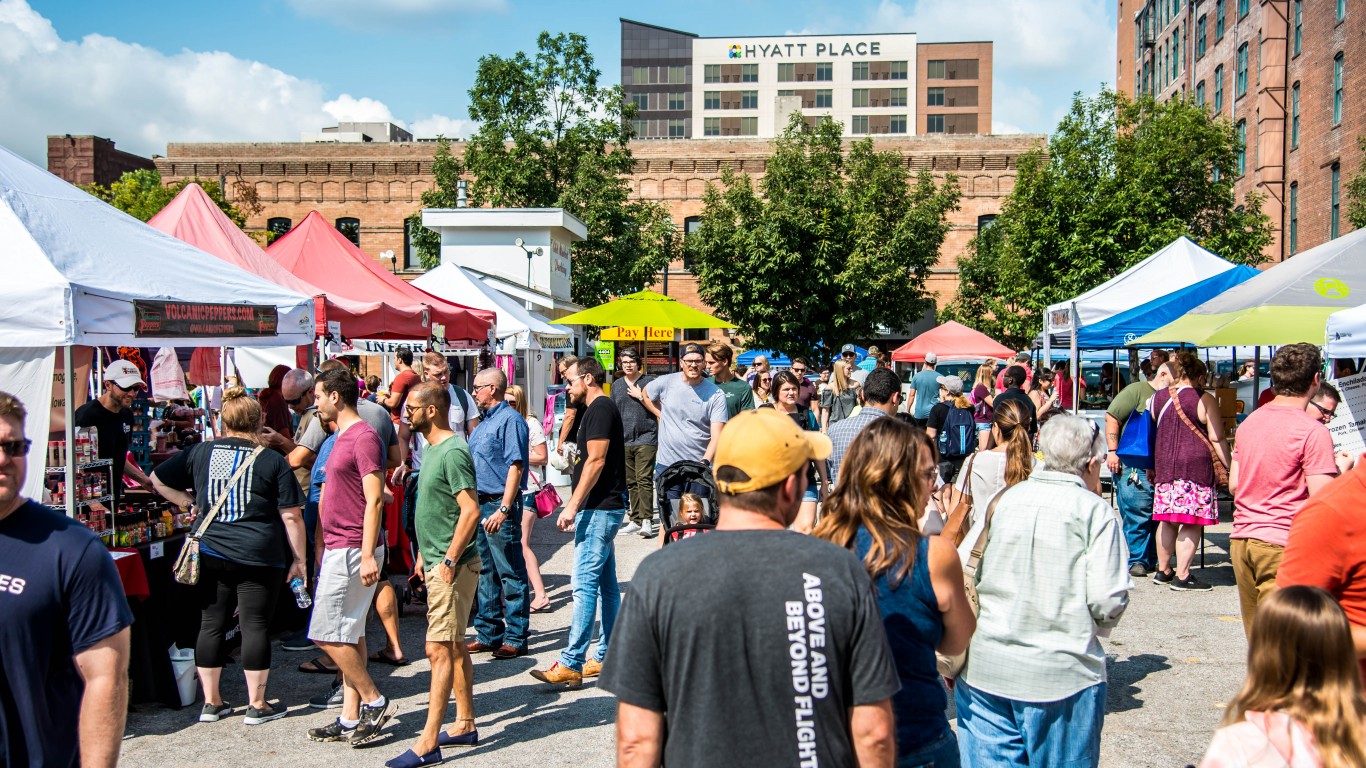
20. Nebraska
> Hate groups in 2019: 3.10 per million people (total: 6)
> Hate groups in 2010: 4.37 per million people — 16th highest (total: 8)
> Pct. pop. identifying as white: 86.2% — 11th highest
> Pct. pop. foreign born: 7.4% — 25th highest
> Median household income: $63,229 — 25th highest
There are six known hate groups in Nebraska, one of three Midwestern states on this list. Two of the hate groups in the state — the racist skinhead AC Skins and the white nationalist Patriot Front — operate statewide.
Hate groups tend to be concentrated in areas where a large share of the population identifies as white. In Nebraska, 86.2% are white, more than 10 percentage points higher than the national share of 72.0%. Only 4.9% identify as Black, less than half the comparable national average of 12.8%.
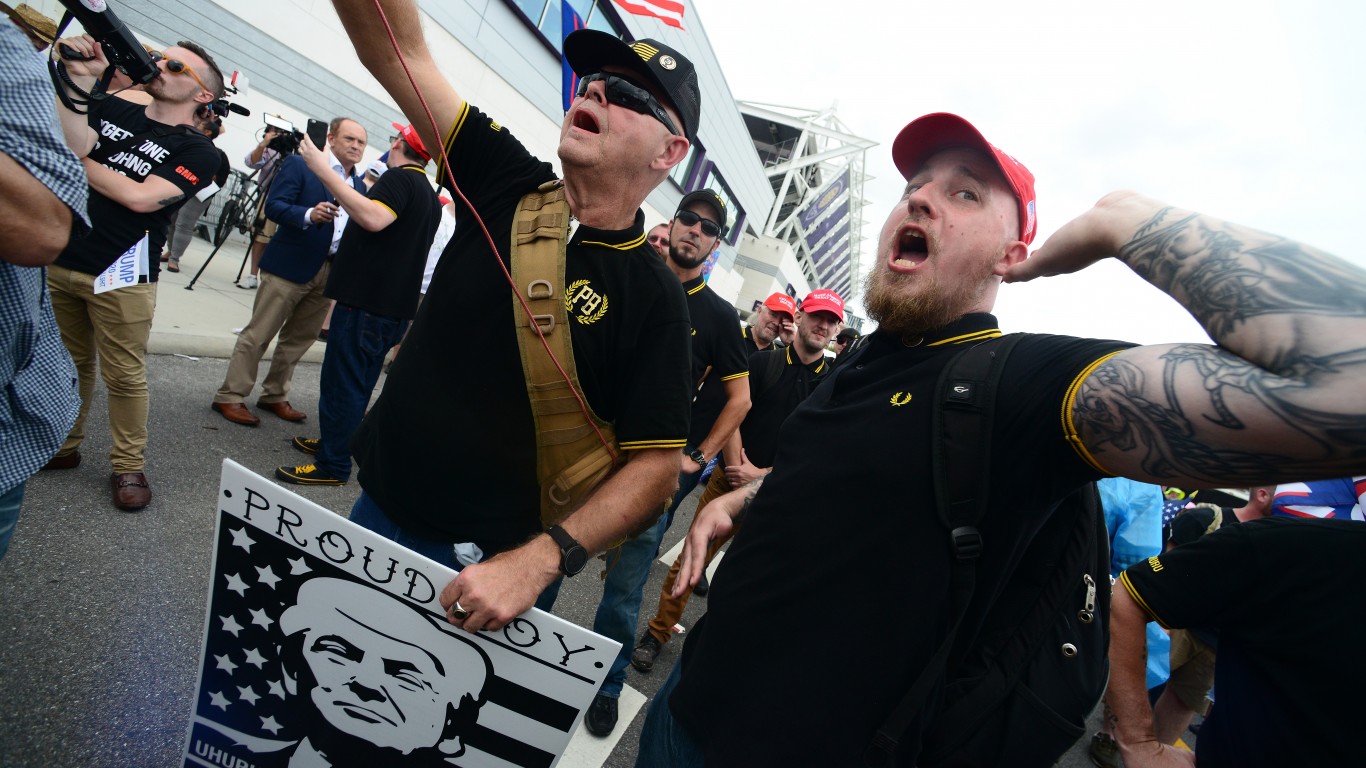
19. Florida
> Hate groups in 2019: 3.12 per million people (total: 67)
> Hate groups in 2010: 2.60 per million people — 19th lowest (total: 49)
> Pct. pop. identifying as white: 74.5% — 21st lowest
> Pct. pop. foreign born: 21.1% — 4th highest
> Median household income: $59,227 — 17th lowest
Almost half of the 67 active hate groups in Florida hold white supremacist ideology, including three Ku Klux Klan, the oldest and most infamous hate group in the country. There are also 19 Black separatist groups, the members of which believe the answer to white racism is separate institutions of Black people, according to the SPLC. Florida is also home to five chapters of Proud Boys, a fairly new hate group, established in 2016 by Vice Media co-founder Gavin McInnes.
Florida, the third most populous state in the country, has one of the most racially diverse populations of any state. About 21.1% of residents were not born in the U.S., the fourth highest share of all states and far larger than the 13.7% share nationwide.
[in-text-ad-2]
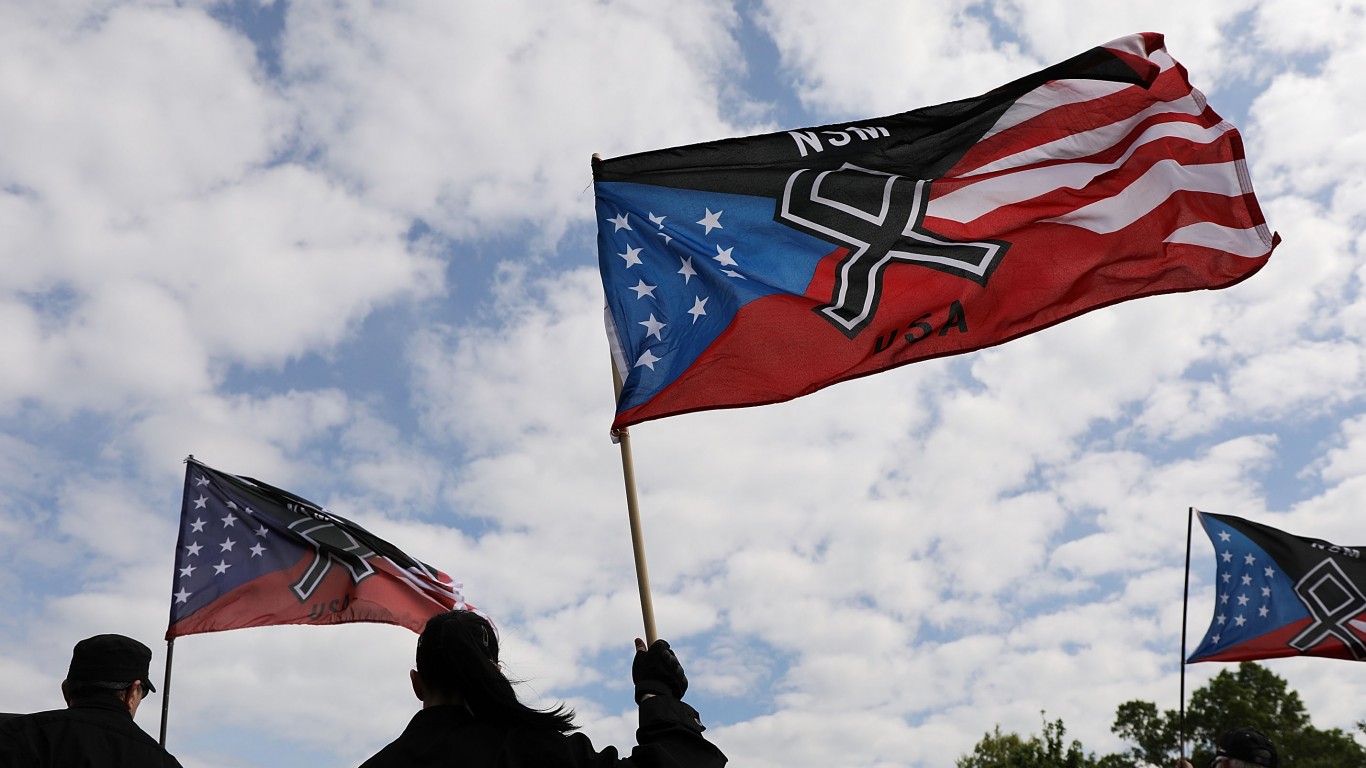
18. Vermont
> Hate groups in 2019: 3.21 per million people (total: 2)
> Hate groups in 2010: 3.20 per million people — 24th lowest (total: 2)
> Pct. pop. identifying as white: 93.8% — 2nd highest
> Pct. pop. foreign born: 4.7% — 12th lowest
> Median household income: $63,001 — 25th lowest
Vermont is the only state in the Northeast to rank on among the states with the most hate groups per capita. There are two active hate groups — the neo-Nazi National Socialist Movement and the white nationalist Patriot Front, both of which operate statewide. In comparison, Maine also has two active hate groups but it is home to more than twice as many people.
Vermont is one of the least racially diverse states in the country. About 93.8% of state residents identify as white, the second highest share in the U.S., and just 1.5% identify as Black, the fifth lowest share among U.S. states.
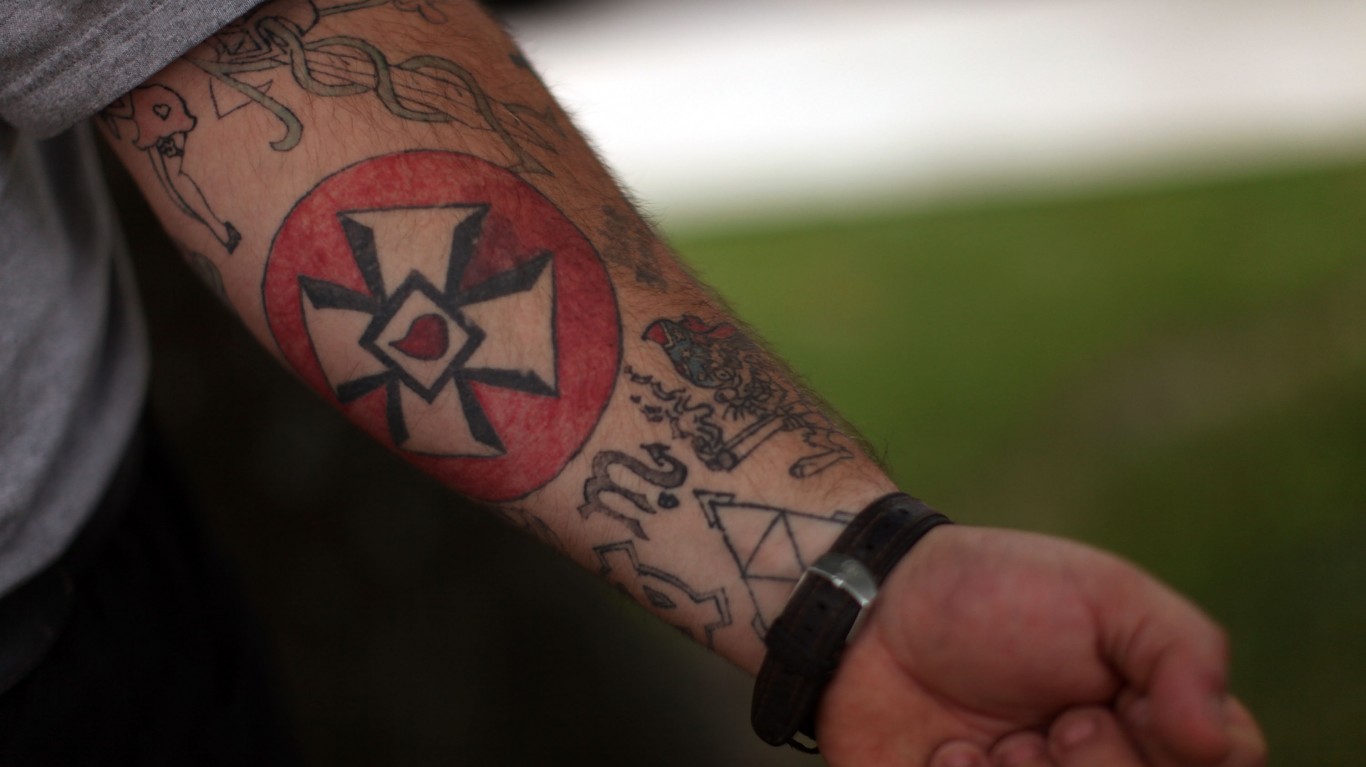
17. Alabama
> Hate groups in 2019: 3.26 per million people (total: 16)
> Hate groups in 2010: 6.90 per million people — 7th highest (total: 33)
> Pct. pop. identifying as white: 67.8% — 14th lowest
> Pct. pop. foreign born: 3.6% — 5th lowest
> Median household income: $51,734 — 5th lowest
Alabama is one of few states on this list where the total number of hate groups has significantly decreased since 2010, from 33 in 2010 to 16 in 2019. The state is home to about as many Black separatist hate groups as white supremacist hate groups. Just over one in four Alabama residents identify as Black, the fifth highest share of any state, compared to a national average of 12.8%. About 67.8% of residents are white, compared to 72.0% nationwide.
Hate groups tend to be concentrated in poorer areas, and about 15.5% of Alabama residents live in poverty, a higher poverty rate than the national rate of 12.3%. The median household income in Alabama is the fifth lowest in the U.S. and about $14,000 less than the national median household income of $65,712.
[in-text-ad]

16. South Carolina
> Hate groups in 2019: 3.30 per million people (total: 17)
> Hate groups in 2010: 6.47 per million people — 8th highest (total: 30)
> Pct. pop. identifying as white: 66.7% — 10th lowest
> Pct. pop. foreign born: 5.6% — 19th lowest
> Median household income: $56,227 — 10th lowest
Like Alabama, about half of the hate groups that were active in South Carolina in 2010 no longer are. Down from 30 hate groups a decade ago, there are now 17 active hate groups in the state, five of which, including the KKK, operate statewide. South Carolina’s population racial makeup is similar to that of Alabama. Of the nearly 5.1 million residents, 66.7% identify as white and 26.5% identify as Black, compared to national averages of 72.0% and 12.8%, respectively.
South Carolina is one of three states without a law criminalizing attacks on people based on their race or ethnicity. FBI statistics show that there were more hate crimes in the state in 2018 than in 2017, the most recent year of available data, especially hate crimes based on religion.
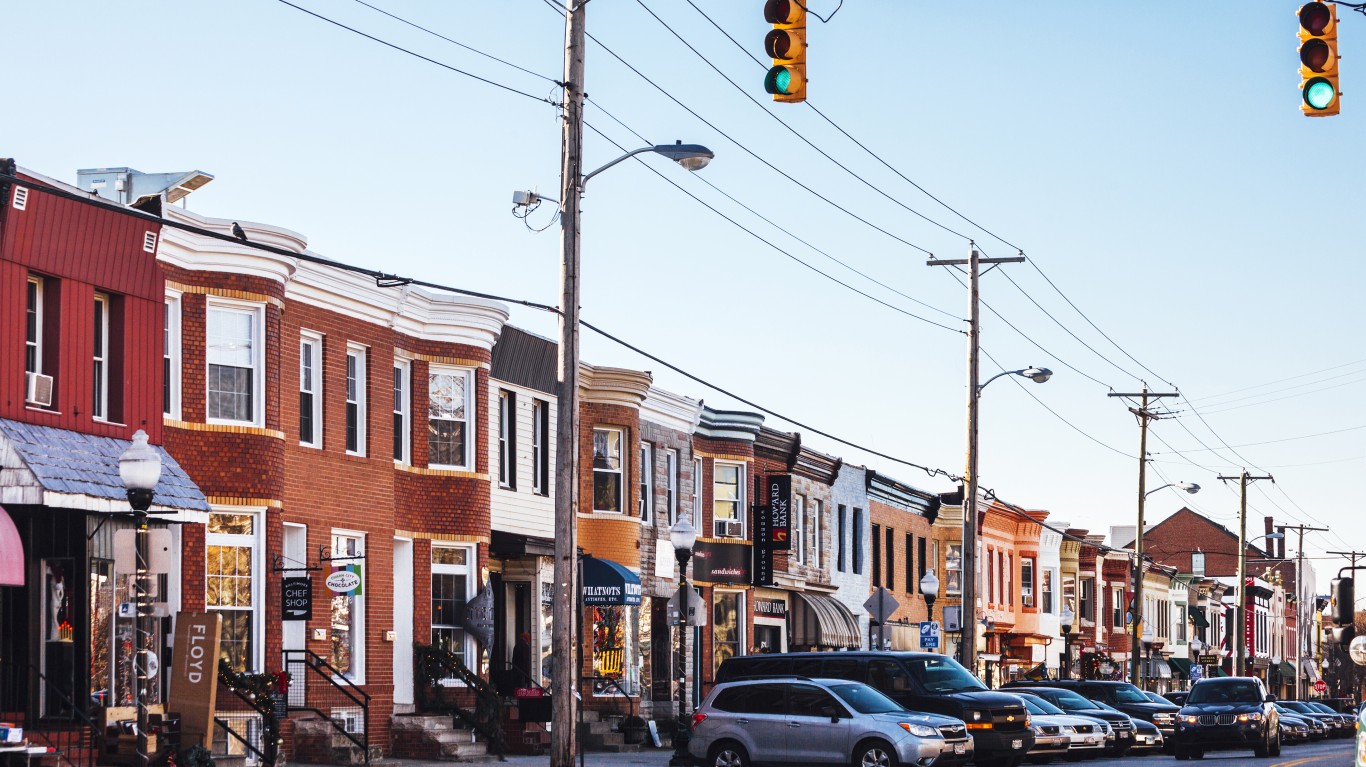
15. Maryland
> Hate groups in 2019: 3.31 per million people (total: 20)
> Hate groups in 2010: 2.94 per million people — 23rd lowest (total: 17)
> Pct. pop. identifying as white: 54.5% — 2nd lowest
> Pct. pop. foreign born: 15.4% — 9th highest
> Median household income: $86,738 — the highest
Maryland has a total of 20 active hate groups, up from 17 in 2010. Five of these groups, the majority of which hold a white supremacist ideology, operate statewide.
Hatred is not exclusively racially motivated in Maryland. Other hate groups include one known anti-LGBTQ group, one anti-Muslim group, and one known anti-immigrant group. In Maryland, 15.4% of residents were born outside of the United States, a larger immigrant population than in the majority of states and higher than the national average of 13.7%.
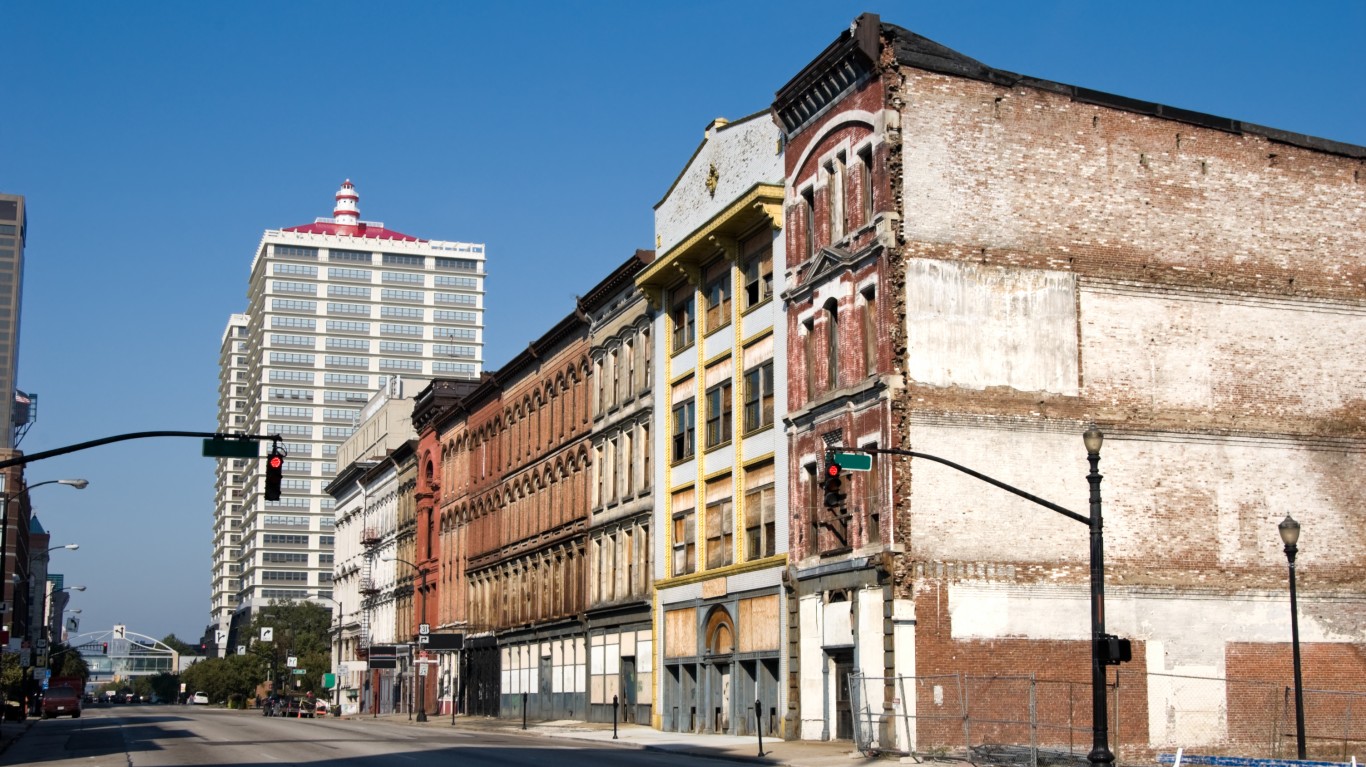
14. Kentucky
> Hate groups in 2019: 3.36 per million people (total: 15)
> Hate groups in 2010: 3.45 per million people — 25th highest (total: 15)
> Pct. pop. identifying as white: 86.7% — 10th highest
> Pct. pop. foreign born: 4.4% — 11th lowest
> Median household income: $52,295 — 7th lowest
Of the 15 known hate groups in Kentucky, four are active KKK groups. Indiana and Tennessee are the only other states with as many active Klan chapters — and they both have a population larger by more than 2 million. Other hate groups in the state include Revolutionary Black Panther Party, a Black separatist group in Louisville, and League of the South, a neo-Confederate group operating in McKee.
Hate groups tend to be concentrated in poorer, less educated areas. The typical household in Kentucky earns just $52,295 a year, about $13,000 less than the typical American household. Additionally, just 25.1% of adults in the state have a bachelor’s degree, the fifth lowest share or any state, compared to 33.1% of adults nationwide.
[in-text-ad-2]
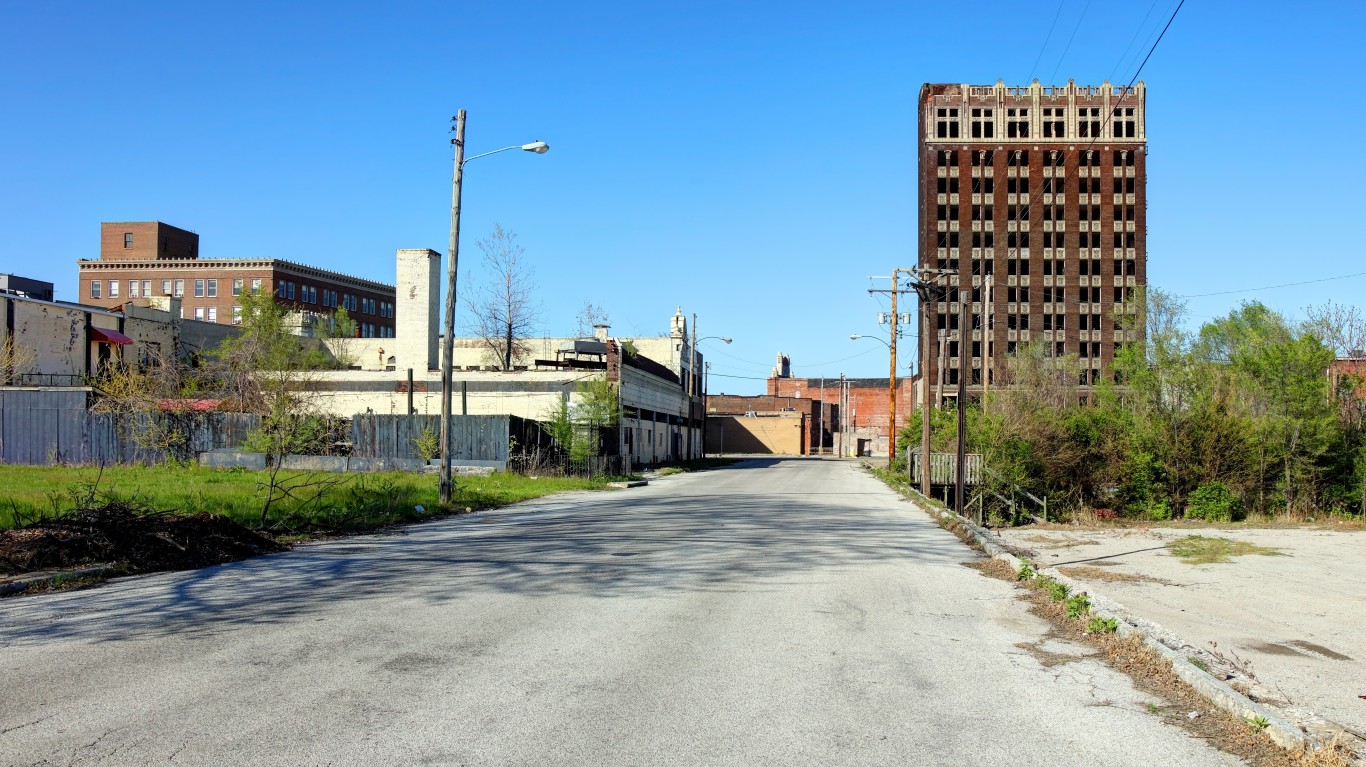
13. Missouri
> Hate groups in 2019: 3.42 per million people (total: 21)
> Hate groups in 2010: 4.34 per million people — 17th highest (total: 26)
> Pct. pop. identifying as white: 81.8% — 20th highest
> Pct. pop. foreign born: 4.3% — 10th lowest
> Median household income: $57,409 — 13th lowest
Missouri is one of three Midwestern states to rank on this list. Ten of the 21 hate groups active in the state are based either in Kansas City or St. Louis. Those groups include several Black separatist groups, an anti-Muslim group known as Act for America, and a Proud Boys chapter.
Missouri is far less racially diverse than the country as a whole. About 81.8% of state residents identify as white, compared to 72.0% of the U.S. population.
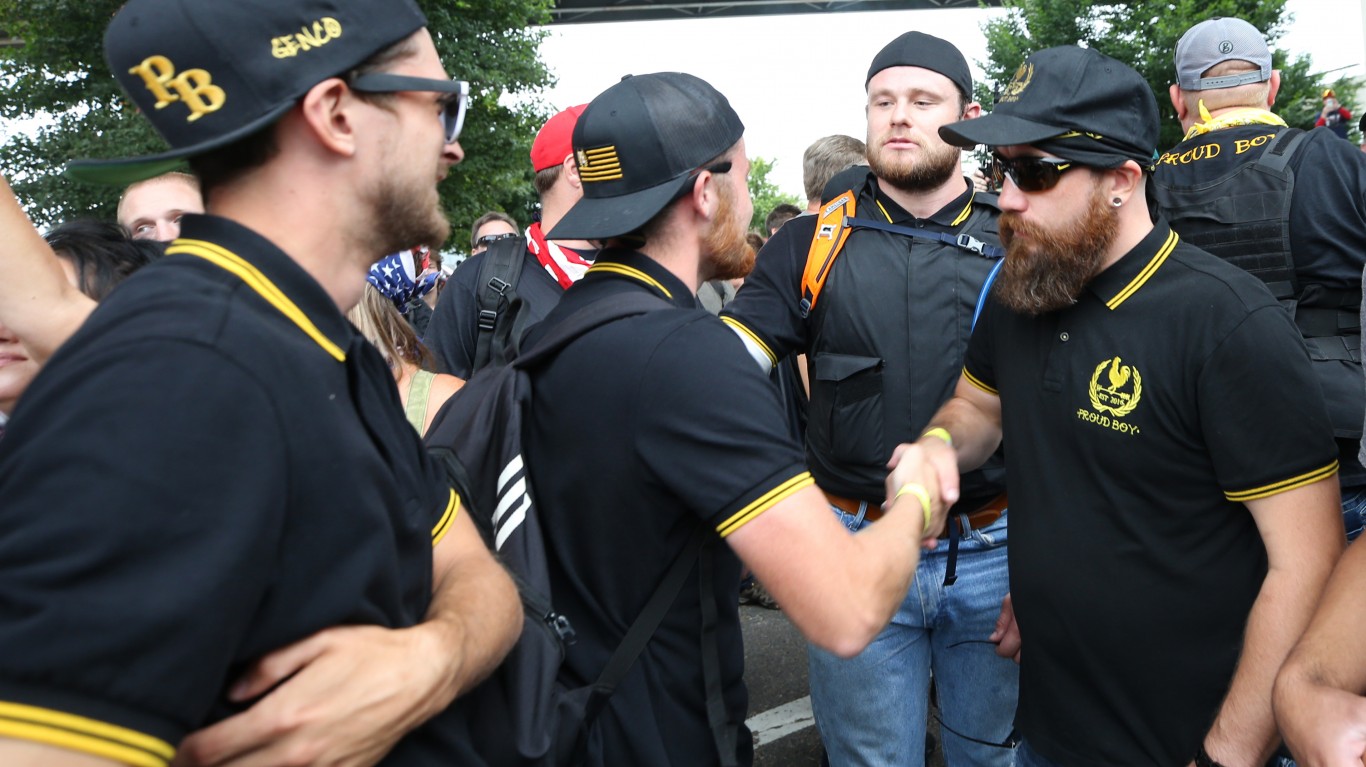
12. Oregon
> Hate groups in 2019: 3.56 per million people (total: 15)
> Hate groups in 2010: 3.91 per million people — 19th highest (total: 15)
> Pct. pop. identifying as white: 83.5% — 17th highest
> Pct. pop. foreign born: 9.7% — 18th highest
> Median household income: $67,058 — 18th highest
Three of the 15 active hate groups in Oregon are based in Salem, including the anti-immigrant Oregonians for Immigration Reform, anti-LGBTQ Pacific Justice Institute, and one of the three chapters of Proud Boys.
Oregon is among the least racially diverse states in the country. About 83.5% of residents identify as white and 1.8% identify as Black, compared to the national averages of 72.0% and 12.8%, respectively. It also has relatively few immigrants, as 9.7% of Oregon’s residents were born outside the U.S., much lower than the nationwide 13.7% rate.
[in-text-ad]
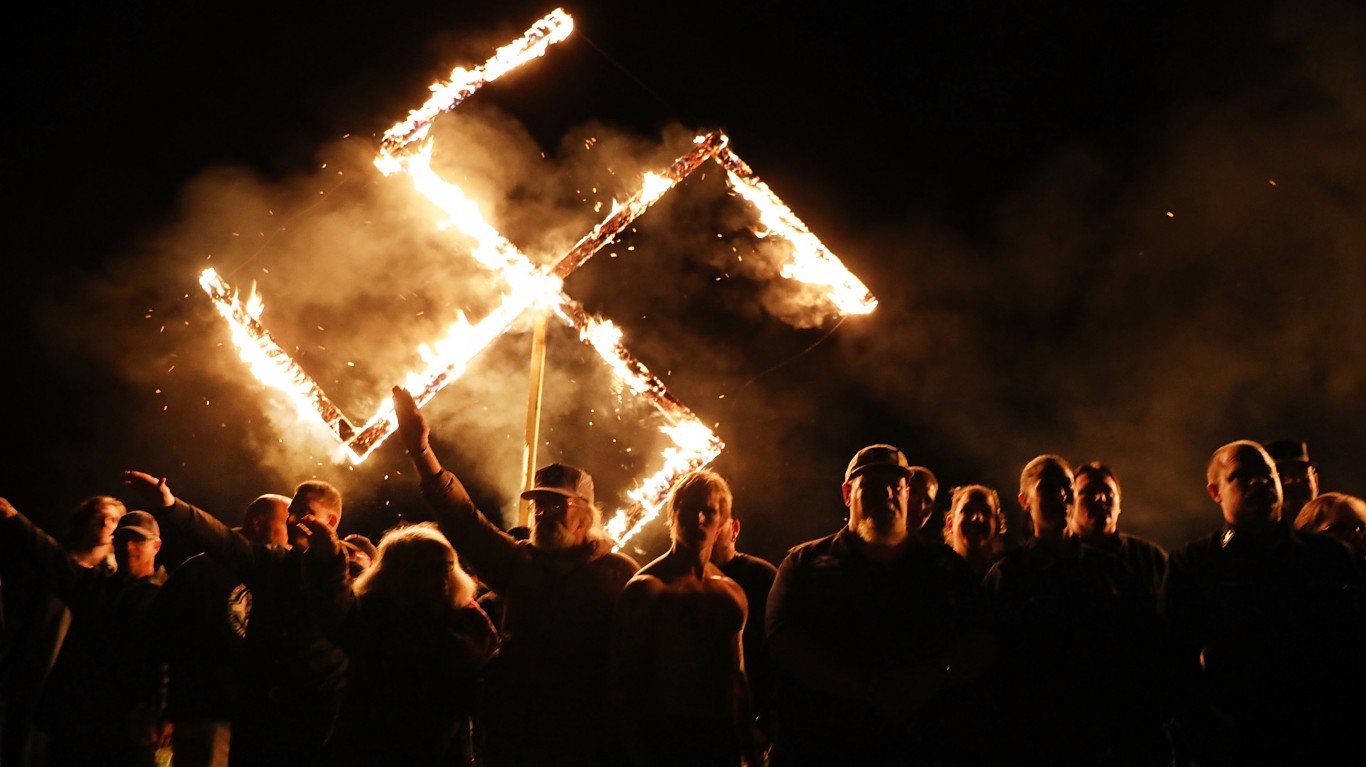
11. Georgia
> Hate groups in 2019: 3.58 per million people (total: 38)
> Hate groups in 2010: 4.02 per million people — 18th highest (total: 39)
> Pct. pop. identifying as white: 57.8% — 3rd lowest
> Pct. pop. foreign born: 10.3% — 16th highest
> Median household income: $61,980 — 22nd lowest
There are 38 known hate groups currently active in Georgia. They include two chapters of the KKK, the oldest and most infamous hate group in the country, and some newer groups, like a chapter of Proud Boys, a group established in 2016, and a Christian identity group.
Georgia, the eighth most populous state in the country, has one of the most racially diverse populations of any state. About 57.8% of residents identify as white, the third lowest share of any state. About 31.9% of state residents are Black, well above the 12.7% national share and the third highest share of all states. Racial bigotry is a central tenet in the majority of hate groups in Georgia — including the 13 known Black separatist groups.

10. Colorado
> Hate groups in 2019: 3.82 per million people (total: 22)
> Hate groups in 2010: 3.76 per million people — 21st highest (total: 19)
> Pct. pop. identifying as white: 83.7% — 15th highest
> Pct. pop. foreign born: 9.5% — 20th highest
> Median household income: $77,127 — 9th highest
Colorado is one of five states from the West to rank among the states with the most hate groups per capita. According to the SPLC, the state is home to 22 active hate groups, up from 19 a decade ago. The current active hate groups in the state include four anti-LGBTQ groups, five white nationalist organizations, five Black separatist, and one anti-immigrant group. Half of the hate groups in the state are based in either Denver or Colorado Springs.
Colorado is far less racially diverse than the country as a whole. About 83.7% of state residents are white, compared to 72.0% of the U.S. population.

9. Idaho
> Hate groups in 2019: 3.92 per million people (total: 7)
> Hate groups in 2010: 8.27 per million people — 5th highest (total: 13)
> Pct. pop. identifying as white: 89.4% — 7th highest
> Pct. pop. foreign born: 5.8% — 20th lowest
> Median household income: $60,999 — 20th lowest
There are seven known hate groups active in Idaho, or almost four for every 1 million state residents. Nationwide, there are 2.9 hate groups for every 1 million people. Religion is a common foundation for hatred among groups in the state. Soldiers of Odin and G416 Patriots are two anti-Muslim groups. There is also a holocaust denial group in Coeur d’Alene and a neo-Nazi group that operates statewide.
Hate groups tend to be concentrated in less educated areas, and about one 28.7% of Idaho residents have a bachelor’s degree compared to 33.1% of adults nationwide.
[in-text-ad-2]

8. Washington
> Hate groups in 2019: 3.94 per million people (total: 30)
> Hate groups in 2010: 1.93 per million people — 11th lowest (total: 13)
> Pct. pop. identifying as white: 74.2% — 20th lowest
> Pct. pop. foreign born: 14.9% — 10th highest
> Median household income: $78,687 — 7th highest
Washington is one of seven states on this list that added the most hate groups in nine years. In 2010, there were 13 known hate groups in the state; now there are 30. The 17 new hate groups include one anti-immigrant group in the state, four anti-LGBTQ groups, three anti-Muslim, three neo-Nazi, three Black separatist, four Proud Boys groups, and one KKK chapter.
Washington state has one of the highest shares of foreign-born residents at 14.9%, compared to the national average of 13.7%.

7. Mississippi
> Hate groups in 2019: 4.03 per million people (total: 12)
> Hate groups in 2010: 13.47 per million people — the highest (total: 40)
> Pct. pop. identifying as white: 58.0% — 4th lowest
> Pct. pop. foreign born: 2.1% — 2nd lowest
> Median household income: $45,792 — the lowest
Though the number of hate groups in Mississippi has significantly decreased –from 40 in 2010 to 12 in 2019 — the state still ranks in the top 10 of states with the most active hate groups per capita. Almost half of the groups are KKK. There are five known KKK groups active in the state, the highest concentration of the infamous white supremacist organization of any state. Other hate groups in the state include the American Family Association, an anti-LGBT group in Tupelo, and League of the South, a neo-Confederate group operating in Holly Springs, and four Black separatist groups.
Hate groups tend to be concentrated in poorer and less educated areas. About one in every five Mississippi residents live in poverty, the highest poverty rate of any state. Additionally, 22.3% of people in the state have a bachelor’s degree or higher, the second lowest share of all states.
[in-text-ad]
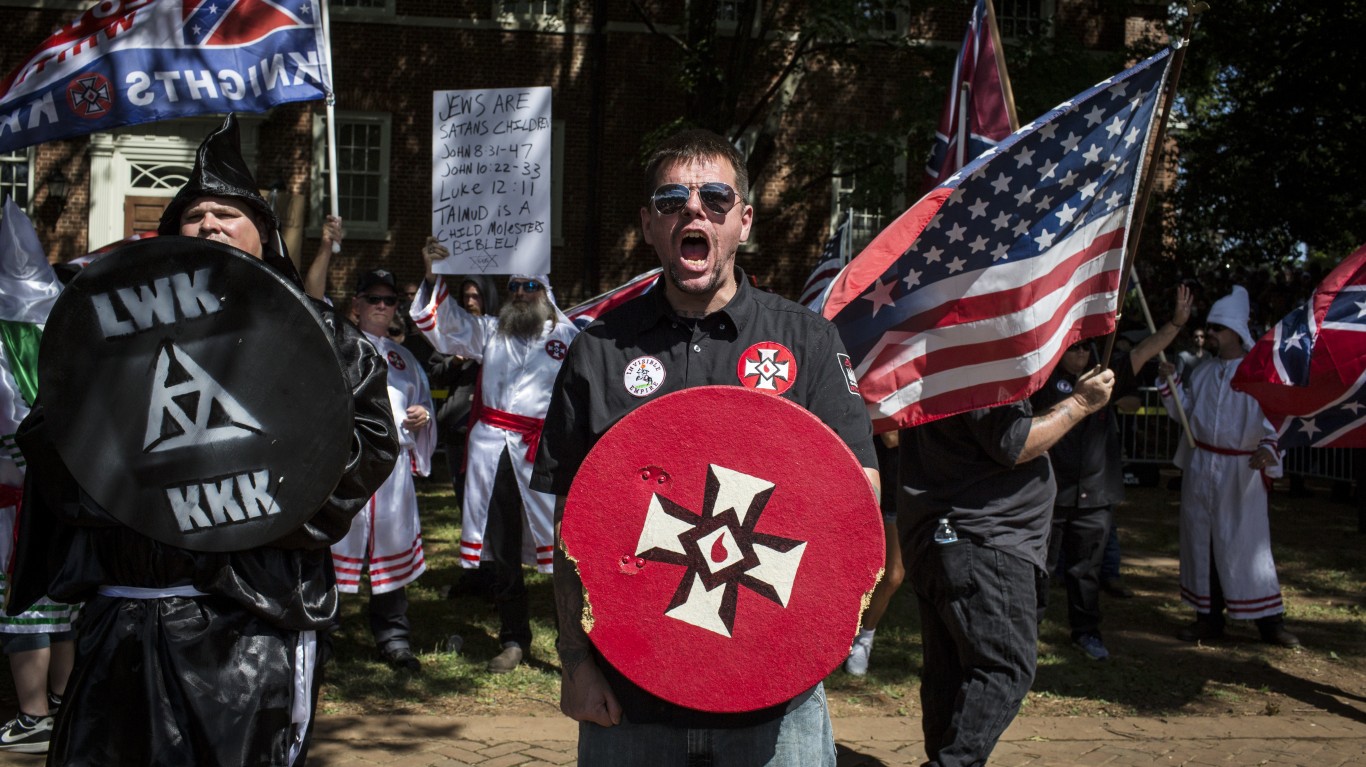
6. Virginia
> Hate groups in 2019: 4.22 per million people (total: 36)
> Hate groups in 2010: 3.61 per million people — 23rd highest (total: 29)
> Pct. pop. identifying as white: 67.0% — 11th lowest
> Pct. pop. foreign born: 12.7% — 15th highest
> Median household income: $76,456 — 10th highest
There are 36 known hate groups active in Virginia, or 4.2 per 1 million people, up from 29 or 3.6 per million residents in 2010. Most of the currently active hate groups hold a white supremacist ideology. Six others are Black separatist, according to SPLC.
Hatred is not exclusively racially motivated in Virginia. There are two known anti-immigrant groups in the state, Arlington-based ProEnglish and the Americans for Immigration Control group in Monterey. In Virginia, 12.7% of residents were born outside of the United States, a larger immigrant population than in the majority of states.

5. Louisiana
> Hate groups in 2019: 4.52 per million people (total: 21)
> Hate groups in 2010: 5.50 per million people — 14th highest (total: 25)
> Pct. pop. identifying as white: 61.8% — 6th lowest
> Pct. pop. foreign born: 4.2% — 9th lowest
> Median household income: $51,073 — 4th lowest
Nearly half of the 21 active hate groups in Louisiana are Black separatists — including three New Black Panther Party groups and three Nation of Islam groups. Louisiana, which has the second highest share of Black residents in the U.S., is also home to three active white nationalist groups, one KKK group, and one neo-Confederate group.
Hate groups tend to be concentrated in less educated areas with high levels of poverty. The poverty rate in Louisiana is 19.0%, the second highest in the country. One in four residents has a bachelor’s degree, the fourth lowest share in the U.S. and far less than the 33.1% of Americans nationwide.
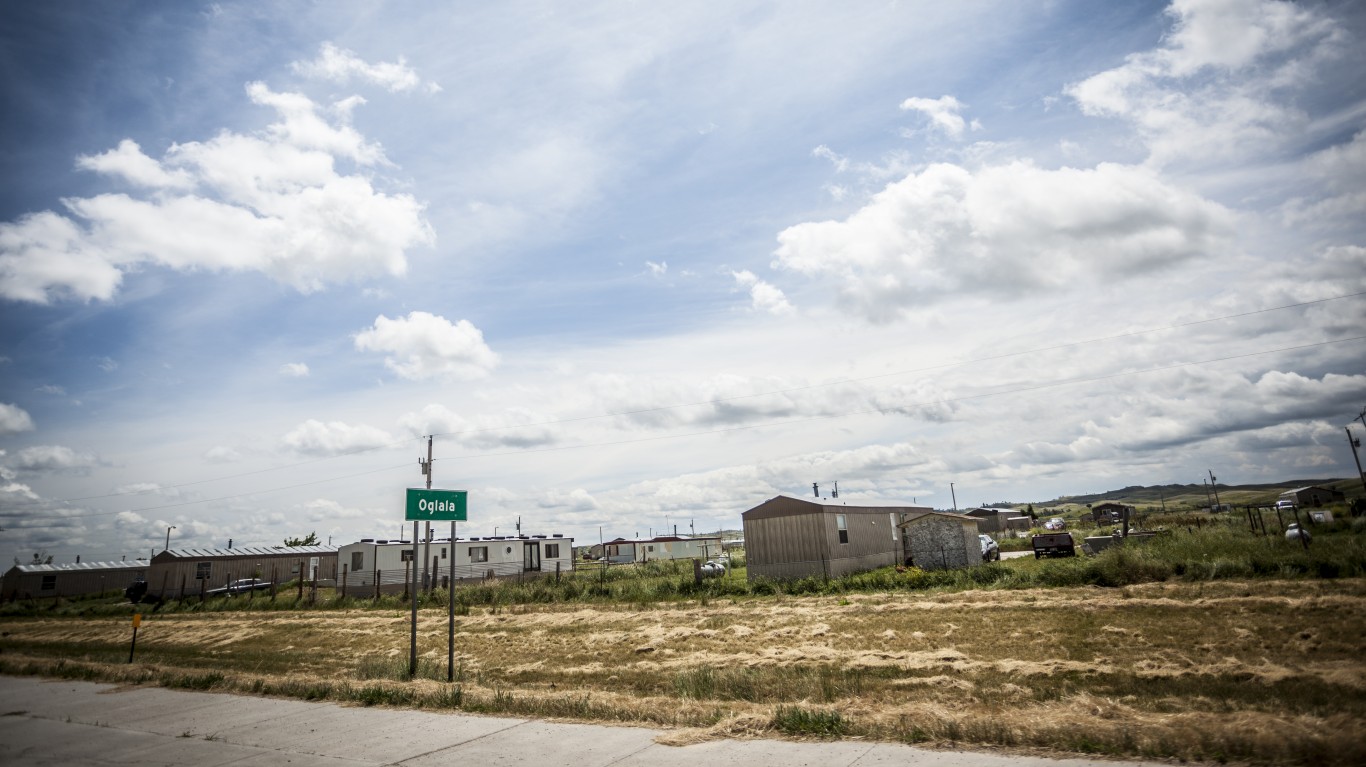
4. South Dakota
> Hate groups in 2019: 4.52 per million people (total: 4)
> Hate groups in 2010: 2.45 per million people — 18th lowest (total: 2)
> Pct. pop. identifying as white: 84.1% — 14th highest
> Pct. pop. foreign born: 4.1% — 8th lowest
> Median household income: $59,533 — 18th lowest
South Dakota is one of three states with no hate crime laws. In the period between 2010 and 2019, the number of hate groups has doubled in the state, from two to four. The other three states with four active hate groups have much larger populations and do not rank on this list. Two of the hate groups in South Dakota — the white nationalist American Identity Movement and The Right Stuff — operate statewide.
South Dakota is far less racially diverse than the country as a whole. About 84.1% of state residents are white, compared to 72.0% of the U.S. population.
[in-text-ad-2]
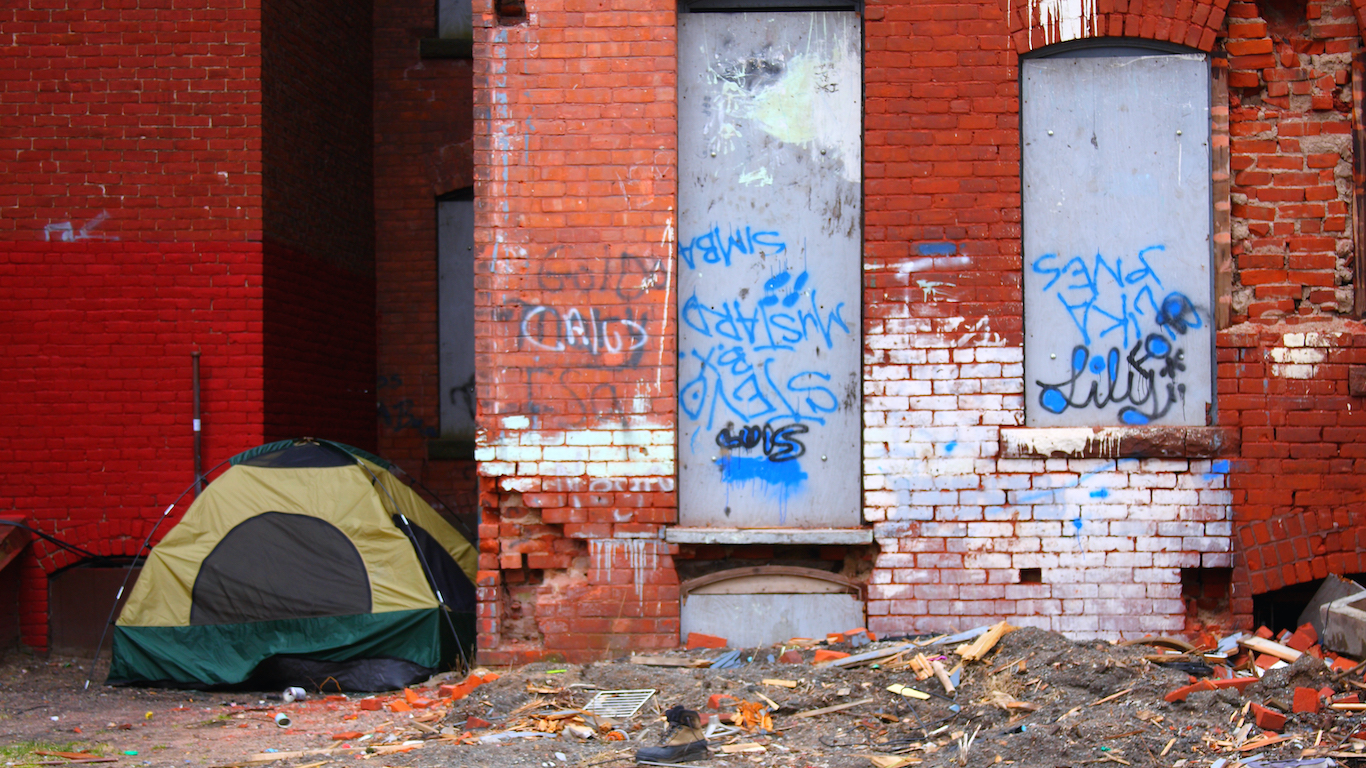
3. Arkansas
> Hate groups in 2019: 4.97 per million people (total: 15)
> Hate groups in 2010: 9.93 per million people — 3rd highest (total: 29)
> Pct. pop. identifying as white: 76.7% — 23rd lowest
> Pct. pop. foreign born: 5.1% — 15th lowest
> Median household income: $48,952 — 3rd lowest
Like South Dakota and Wyoming, Arkansas has no hate crime laws (though a legislation was proposed in August). A third of the 15 hate groups active in Arkansas are headquartered in the small city of Harrison, not far from the Missouri border. Those groups include the neo-Confederate League of the South, two Christian identity groups, and the Knights of the Ku Klux Klan, the only known KKK chapter active in the state.
Hate groups tend to be concentrated in poorer, less educated areas. The typical household in Arkansas earns just $48,952 a year, about $17,000 less than the typical American household and the third lowest in the U.S. Additionally, just 23.3% of adults in Arkansas have a bachelor’s degree compared to 33.1% of adults nationwide.

2. Tennessee
> Hate groups in 2019: 5.56 per million people (total: 38)
> Hate groups in 2010: 5.51 per million people — 13th highest (total: 35)
> Pct. pop. identifying as white: 77.2% — 25th lowest
> Pct. pop. foreign born: 5.5% — 17th lowest
> Median household income: $56,071 — 9th lowest
There are 5.6 active hate groups for every 1 million people in Tennessee, the most of any state in the South. Over half of the hate groups in the state are largely racially motivated. These groups include four KKK chapters, seven white nationalist groups, and eight Black separatist groups. In Tennessee, there are also four anti-Muslim groups — in Coffee County, in Franklin, in Knoxville, and in Nashville.
About 16.7% of residents identify as Black, a larger share of the population than in the majority of states.
[in-text-ad]
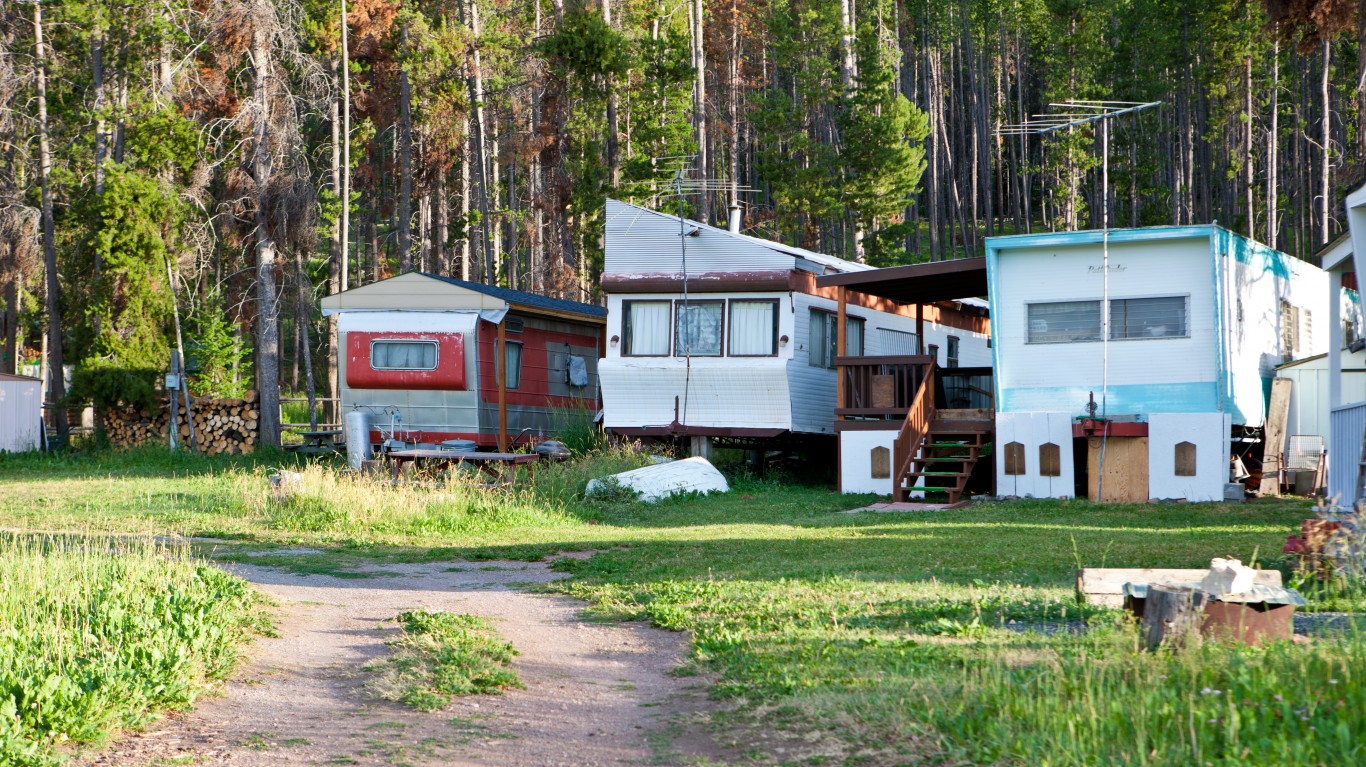
1. Montana
> Hate groups in 2019: 5.61 per million people (total: 6)
> Hate groups in 2010: 13.12 per million people — 2nd highest (total: 13)
> Pct. pop. identifying as white: 88.0% — 8th highest
> Pct. pop. foreign born: 2.3% — 3rd lowest
> Median household income: $57,153 — 11th lowest
Though Montana has relatively few hate groups active in the state, due to its small population — just over a million people — the state tops the list of states with most hate groups per capita. Montana ranked second in 2010. Four of the six hate groups in the state in 2019 hold white supremacist ideology.
The state is among the least racially diverse in the U.S. Just 0.7% of residents identify as Black, the second lowest share in the U.S., tied with Idaho, and 88.0% of state residents identify as white, a far higher share than the 72.0% of Americans who do.
Methodology
To identify the states with the highest concentration of hate groups, 24/7 Wall St. reviewed the number of hate groups in each state for every 1 million state residents in 2019, according to data provided by nonprofit civil rights advocacy group Southern Poverty Law Center.
To be considered for our ranking, a state needed to have at least three active hate groups per million residents. Activity is deemed as on-the-ground activity such as holding rallies or accepting memberships and selling literature.
We also reviewed the foreign-born population in each state, the percentage of adults with at least a bachelor’s degree, the percentage of each state’s population that is white, poverty rate, and median household income. These data came from the U.S. Census Bureau’s 2019 American Community Survey.
Credit card companies are pulling out all the stops, with the issuers are offering insane travel rewards and perks.
We’re talking huge sign-up bonuses, points on every purchase, and benefits like lounge access, travel credits, and free hotel nights. For travelers, these rewards can add up to thousands of dollars in flights, upgrades, and luxury experiences every year.
It’s like getting paid to travel — and it’s available to qualified borrowers who know where to look.
We’ve rounded up some of the best travel credit cards on the market. Click here to see the list. Don’t miss these offers — they won’t be this good forever.
Thank you for reading! Have some feedback for us?
Contact the 24/7 Wall St. editorial team.